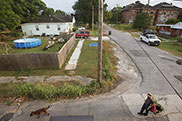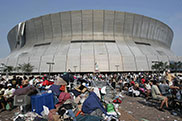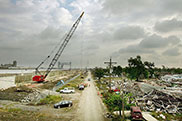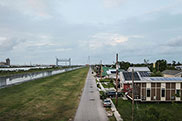 David J. Phillip/AFP/Getty Images
David J. Phillip/AFP/Getty Images
Article
In the aftermath of the most destructive storm in U.S. history, people learned valuable lessons. Yet with as much progress as was made, did everyone miss the most important one of all?
Learn the why behind the headlines.
Subscribe to the Real Truth for FREE news and analysis.
Subscribe NowKatrina was labeled “the worst storm to hit the worst possible location.” A full decade later, other descriptors such as strongest, costliest and deadliest still apply to the catastrophe. The record-breaking hurricane devastated a nation’s psyche along with historical communities and extensive infrastructure.
The tropical storm originally formed off the coast of the Bahamas on August 23, 2005. By the time it dissipated eight days later, the entire Gulf Coast was affected. Areas of Florida, Alabama, Mississippi and Louisiana were left completely destroyed. The damage totaled a staggering $108 billion with a reported death toll of 1,836. Many more thousands were left injured and homeless.
 Robyn Beck/Getty Images
Robyn Beck/Getty Images Robyn Beck/Getty Images
Robyn Beck/Getty ImagesMost disaster anniversaries are familiar. The focus turns to continuing recovery efforts, commemorating acts of bravery, and getting “where are they now” updates on key players involved during the tragedy’s most critical stages. The 10th anniversary of the super storm will no doubt feature these and other observances.
Reflecting on the havoc caused by Hurricane Katrina and the heartfelt response from people around the world can help bring closure to what were considered some of the worst days in the lives of many. Revisiting the destruction and suffering caused by the storm also brings the opportunity to engage in a quality central to the human experience—the chance to learn life-changing lessons.
George W. Bush, the president at the time, emphasized this to the country in the days following the storm: “This government will learn the lessons of Hurricane Katrina. We are going to review every action and make necessary changes so that we are better prepared for any challenge of nature, or act of evil men, that could threaten our people” (whitehouse.gov).
The leader of the free world clearly understood the importance of taking heed to avoid the mistakes of the past.
Hindsight, by its very nature, brings clarity. Looking back at our experiences exposes, with remarkable detail, the actions that led to either success or failure. The fact that an experience may be one of tragedy and suffering only serves to increase the significance of valuable lessons learned.
Did we learn anything from Hurricane Katrina? Absolutely. The storm exposed numerous flaws in dispatching weather warnings, coping with aging infrastructure, organizing disaster response, and intergovernmental communication. The country learned the hard way about the need to fix weaknesses in these and other important areas.
The complete devastation caused by the storm gave the extremely rare chance to begin whole communities from scratch. With a fresh start, developers could implement important principles of urban planning and economic development.
A shining example of this is the city of New Orleans, Louisiana. The destruction, and super funding that came as a result, allowed whole parts of the city to be completely rebuilt. Some say that overall conditions are better post-storm than prior. Incomes are up, schools are improved, and business is booming. In addition, most residents have returned, businesses old and new are open—even tourism is approaching pre-storm levels.
Ten years later, a rejuvenated region shows that many of the lessons learned through the tragedy have stuck. Citizens came together. Neighborhoods were rebuilt. Processes were updated. Out of the storm came tremendous progress and undeniable success.
Despite an encouraging track record of improvement, however, one lesson presented by the tragedy has proven more difficult to grasp.
“Perfect” Storm
Hurricane Katrina came at an extraordinary time for the United States. The country was only four years removed from the tragedy of September 11, an event that considerably impacted the nation’s sense of invincibility. The terrorist act led to a complete overhaul of key areas of emergency preparedness and response. The storm was the first significant post-9/11 test.
America was not ready for what hit it. Yes, the terrorist attacks were devastating, but Katrina was another matter entirely.
The 115-130 mile-per-hour winds of the hurricane revealed the nation’s shortcomings. The aftermath of the storm became a living example of the well-known saying, “Adversity introduces a man to himself.”
Katrina certainly brought adversity.
More than a coordinated attack on isolated targets, the storm was an out-of-control behemoth, producing hurricane-force winds extending an astounding 103 miles from its center. The storm surge, a massive wall of water 27 feet high in some places, was equally devastating.
In the end, the damage caused by the hurricane extended far beyond any one building, city or even state. As reported at the time, the unusually large storm impacted a land area rivaling the size of Britain.
The storm left a trail of destruction along the Gulf Coast that affected thousands of businesses, residences and other properties. It was said that if the extraordinary amount of debris left behind from the storm were to be stacked into a space the size of a football field, the pile would reach more than 10-and-a-half miles high.
More than 300,000 homes were destroyed or left uninhabitable. Businesses remained closed for months or never reopened as insurance claims and government loan requests overwhelmed the system.
With no place to live or work, many were uprooted and forced to relocate to different parts of the country. An October 2005 to October 2006 Current Population Survey of Katrina victims by the Bureau of Labor Statistics revealed that an estimated 1.5 million people aged 16 and older left their residences in Louisiana, Mississippi and Alabama.
Communications, electricity and sanitation systems were also destroyed. Even the ecology was adversely effected. The storm triggered at least 10 oil spills in the region, which combined spewed in excess of 7.4 million gallons of oil into Gulf Coast waterways.
It was only after the storm that adversity revealed America’s shortcomings.
When the winds died down and storm clouds cleared, problems such as poverty, racial inequality, inadequate education, government partisanship, and failing infrastructure entered the national conversation—all at once.
 James Nielsen/AFP/Getty Images
James Nielsen/AFP/Getty Images Rob Carr/Getty Images
Rob Carr/Getty ImagesFew could have imagined the horrific scene of women, children and the elderly suffering in the New Orleans Superdome. Or fathomed the anguish on the faces of those stranded on rooftops or wading through waist-deep water trying to find refuge.
Adding insult to injury were governmental problems. Local authorities fought with state authorities. State authorities fought with federal authorities. The Federal Emergency Management Agency or FEMA, an organization formed for the sole purpose of handling these types of events, was also in the bureaucratic mix.
The most powerful nation in the history of mankind could not seem to get out of its own way. Hurricane Katrina revealed in graphic detail that 21st-century America still had many difficult lessons to learn.
What We Missed
The Gulf Coast region has bounced back over the last 10 years. Americans have once again proven to be a resilient people and this quality certainly manifested itself during the disaster recovery.
After staring into the face of adversity, coming together, and learning valuable lessons, all the area’s problems have been resolved, right?
Of course not. Progress has been made at least on the surface, but the entire region—and the entire nation for that matter—is still mired in many of the same issues that were there prior to the storm.
- Poverty: According to a 2012 Census Bureau report, the number of Americans living in poverty is 49.7 million—more that 16 percent of the population. Lack of income leads to inadequate housing, lack of food, substandard healthcare, substance abuse, and crime, to name a few consequences.
- Racial unrest: Race relations are trending toward lows not seen in America since the 1960s. Altercations between police officials and minorities and violence against others based on race or ethnicity are on the rise. According to a CBS News/New York Times poll, 61 percent of Americans say race relations in the U.S. are bad. The percentage is up from 33 percent in April 2014.
- Poor education: The U.S., once a world leader in education, ranks 39th in the world. Sixty-one percent of fourth graders scored “below proficient” on standardized testing, which means they are not reading at grade level.
In addition, only one in four students graduate from high school prepared in the four core subjects of English, reading, math and science. Teacher quality also suffers from lack of tenure—4 percent of new teachers resign after the first year, 33 percent after three years, and nearly 50 percent after five years.
- Hyper-partisanship: America is a divided nation. The view that those on the “other side of the aisle” operate with good intentions, held as recently as the mid-1980s, is a thing of the past. The concept of partisanship has now been replaced by “hyper-partisanship.” This has led to intense disagreement, name-calling and even violence. Nearly every subject is seen through the lens of political affiliation and ideology, which makes it nearly impossible to get anything of substance accomplished.
- Failing infrastructure: Infrastructure connects the country’s businesses, communities and citizens. It also drives the economy and improves Americans’ quality of life. The U.S., long known for having world-class infrastructure, now receives a grade of D+ on its infrastructure report card. An estimated $3.6 trillion of investment is needed by 2020 to improve it merely to a grade of B.
The U.S. sees these problems and the suffering associated with them. Yet, while these instances of adversity do reveal the nation to itself, there is another step that it fails to take.
This additional step is the only way to solve these problems for good.
 Mario Tama/Getty Images
Mario Tama/Getty ImagesThen: Workers rebuild a levee that was breached by a Hurricane Katrina storm surge along the Industrial Canal in the Lower Ninth Ward (April 25, 2006).
 Mario Tama/Getty Images
Mario Tama/Getty ImagesA Bible passage in Ecclesiastes shows what the nation misses: “In the day of prosperity be joyful, but in the day of adversity consider: God also has set the one over against the other, to the end that man should find nothing after him” (7:14).
In other words, enjoy the good times. But when adversity comes—and it will assuredly come—truly consider the path of your life.
Suffering kicks the learning mechanism into gear. When going through something difficult, we become innately focused on doing what is necessary to not only come out of the distress successfully, but also avoid it in the future.
Merriam-Webster Dictionary defines the word consider as to “think carefully about something.” Human beings benefit from periodically searching diligently for lessons and learning them.
Obviously, certain things were considered after Katrina—and positive changes were made. Yet the worst characteristics revealed in the aftermath of the storm remain.
One would think that the problems occurring in the world’s most prosperous nation would cause more people to “think carefully” about them. Yet most ignore them, assuming they are other people’s problems.
While some do dedicate their lives to addressing them, even their solutions do not get to the heart of their root causes.
Why Katrina?
Notice that Ecclesiastes explains that it is God who has set days of prosperity and adversity. In other words, God intended for mankind to not only have good times, but also bad times as well—times that inevitably lead to suffering.
It may be shocking to read that God intended suffering. It probably seems confusing that a Being who says He loves the world (John 3:16) allows bad things to happen.
However, with the understanding that suffering causes mankind to consider or “think carefully,” a foundation is laid toward understanding the great purpose adversity serves. (For more on this fascinating subject, watch David C. Pack’s powerful World to Come video titled, Why God Allows Human Suffering. It will change you.)
Before elaborating on what element of suffering we are to carefully consider, it is important to clarify how God allowing hardship relates to the terrible events of Hurricane Katrina.
A popular belief at the time of the tragedy was that somehow God was punishing areas of the Gulf Coast for sinful behavior. This included the idea that the storm hit because God was displeased due to the sizeable gambling industry in parts of Mississippi and Alabama or the permissive behavior and promiscuity generally associated with New Orleans.
This is misguided thinking.
Yes, there are consequences for actions (Rom. 6:23), and Bible prophecy does speak about a coming great chastisement for wrong behavior. But to relegate what happened during Katrina purely to punishment for “those people down there” misses the point. It also challenges fundamental logic.
What about all other places in the world that engage in the same—if not worse—activity? Why has God not destroyed those areas with hurricanes? Also, if God was uniquely upset with the behavior in the Gulf Coast region, why has He allowed much of what was destroyed to be rebuilt so that the same improper behavior could continue? Biblical history shows that when God destroys an area for reasons of sin, He is able to ensure nothing is ever built there in the future. (An example is Sodom and Gomorrah, which to this day is not inhabited.)
The explanation as to exactly why certain people were killed in New Orleans and others spared can be known. The Bible speaks to “time and chance” (Ecc. 9:11), which means that some things simply happen without necessarily having a greater divine purpose—they are simply a part of life.
God’s involvement in what occurred may simply be the trend of overall increased bad weather and other natural phenomena foretold to affect Earth—not just New Orleans—at the end of the age.
Instead of dismissing what happened on the Gulf Coast, we would be best served to reflect on what happened there as well as other tragedies throughout the world, no matter where we live.
Ask: What about the vast amount of people who died not only in this storm, but also in other deadly events? How do their deaths relate to learning lessons of adversity?
This is a larger question, however, it has partly been answered. Their deaths, and the despair and fear associated with them, should send a message to those who remain alive. We should carefully consider that life is temporary and fragile, and therefore should live it a certain way.
In other words, when considering, make sure it is your own life you are looking at—do not cast stones at others.
But what about those who died in Katrina? How does God expect them to learn lessons from adversity?
The answers to these questions can be found by answering a different question, “What happens when you die?”
 Dave Einsel/Getty Images
Dave Einsel/Getty ImagesYou may be surprised to learn that the victims of Katrina will have a chance to apply the many lessons of adversity. (For more on this subject read the article What Happens When You Die? You will learn the answer to this question and much more.)
We have seen that God allows mankind to suffer. But what lesson does He intend for us to learn?
Greater Purpose
Dealing with seemingly unsolvable problems is not just a problem for America. If anything, the troubles the nation faces are a fraction of those seen in other parts of the world. The fact that most places look to the U.S. for relief from their problems makes this plain.
Adversity is commonplace across the world: war in the Middle East, terrorist attacks in Europe, earthquakes and typhoons in East Asia, and famine in various nations of Africa. These are just a handful of the troubles mankind faces—troubles that have been around long before now and that go all the way back to the beginning of man’s existence.
For thousands of years, human beings have suffered through starvation, disease, war, poverty, weather disasters, and ultimately death. While we know that God said such days of adversity would come, what exactly does He want us to consider?
In a world cut off from God (Isa. 59:2), suffering is a tool to first get our attention. Adversity shows us something is not right, that there is a deficiency in our lives. The magnitude and inevitability of many of these issues should help us realize that resolving them can only be accomplished by a power greater than ourselves.
But it does not stop there. Once we are focused, we are then prepared to learn the most valuable lesson of all—how to build godly character, meaning the same character God has.
A righteous God does not ask human beings to do what He is unwilling to do. Even professing Christians know that Jesus Christ, God manifest in the flesh (John 1:1, 14), suffered throughout His relatively short life, which ended in horrific death.
But most overlook a key reason why.
Read the following from Hebrews 5:8-9: “Though He [Christ] were a Son, yet learned He obedience by the things which He suffered; and being made perfect, He became the author of eternal salvation unto all them that obey Him…”
Did you notice that? Christ learned obedience through suffering.
What powerful understanding! Not only do we see that suffering led to obedience, but equally astonishing, we see that God, who is a perfect Being, also suffers. Longsuffering, meaning to suffer long, is one of the fruits of God’s Spirit (Gal. 5:22) and an additional proof of this.
Suffering should help us draw closer to God and strive to become more like Him. A person is not complete until they have come through days of adversity and the trials and tribulations they bring—all of which are a guaranteed part of life.
Until this lesson sinks in, mankind will always be forced to deal with problems on his own. In other words, they will remain unsolvable.
Worsening Times
Mankind’s current adversity is only the beginning. As the population strays further away from God’s Way, difficulties will increase.
The Bible describes the worst time in the entirety of human history as being just around the corner. It is referred to in various places as Jacob’s trouble (Jer. 30:5-7) and Satan’s wrath (Rev. 12:12), but most know it as the Great Tribulation (Matt. 24:21).
The word tribulation means pressure. This time of great or intense pressure will initially come upon the modern nations descended from ancient Israel, before affecting the entire world.
Matthew 24 expands on the run-up to this time: “And you shall hear of wars and rumors of wars: see that you be not troubled: for all these things must come to pass, but the end is not yet. For nation shall rise against nation, and kingdom against kingdom: and there shall be famines, and pestilences, and earthquakes, in divers [various] places. All these are the beginning of sorrows” (vs. 6-8).
These conditions are happening all around us now!
The latest conflict between nations and peoples, the continued spread of hunger and disease, and the next volcano or hurricane, should all combine to help us consider even more the signs of the times.
Our reactions should be increased introspection about the fact that God wants people to obey Him and His spiritual Law. This adversity should lead us to consider our ways and learn obedience.
We can now look at the coming suffering as having another purpose. Instead of simply seeing what is coming as retribution, we can look at the benefits that come with suffering. Learning these lessons effectively can help mankind draw closer to God and, even more remarkable, become like Him.
Understand God uses suffering as a tool to implement His magnificent Plan to produce sons (John 1:12; Rom. 8:14).
To learn more about this amazing Plan and the answers to many questions that have perplexed mankind for ages, order David C. Pack’s free book The Awesome Potential of Man. This extraordinary piece of literature addresses many fundamental subjects and explains them in plain, easy-to-understand language.



